

The history of the Christian church, the principal social institution in the Middle Ages, is inextricably linked with the history of music in medieval Europe. Many of the characteristics of Western art music developed out of the needs of the church, from the development of musical notation to the advent of polyphony. With the church as a major player in the development of Western music in the Middle Ages, it comes as no surprise that church music from that era was the best preserved for posterity.
Given that Christianity began as an offshoot of Judaism, many of the Christian musical traditions came from the Jewish musical traditions. One prime example of this is the singing of psalms, sacred songs or hymns, found in the Hebrew Book of Psalms. Likewise, as cantillation (chanting of sacred texts) was and is commonplace in the Jewish synagogue, it also found a home in Christianity through various forms of chant, the most well-known being Gregorian chant. Just as theological (and political) divisions resulted in varying forms of rites, liturgies, and church calendars, divisions in the church resulted in a number of chant dialects, including Gregorian, Byzantine, Ambrosian, and Old Roman chant.
The Byzantine Church, the predecessor to modern-day Orthodox churches, held services that included Scriptural readings that were chanted. The melodies of the Scriptural chants reflected the text's phrasing and were developed based on formulas, while those chants of hymns and psalms were fully developed melodies. The hymn chants, by far the most pervasive and permanent characteristic of the Byzantine Church, were notated in books as early as the tenth century, and many of the chants are still sung in Greek Orthodox services today.
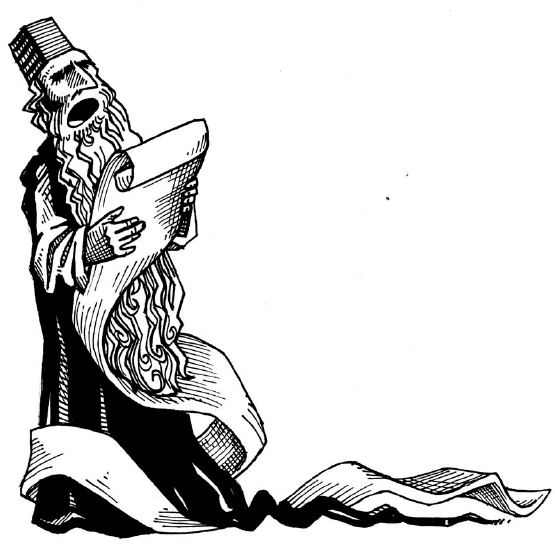
In the Western Church, the most important religious and musical center outside of Rome was the city of Milan. The songs and chants that developed in this northern Italian city became known as Ambrosian chant, named after St. Ambrose, the bishop of Milan between the years 374 and 397. Although there have been movements to suppress them, Ambrosian liturgy and chant still survive in Milan to this day, and they do share common characteristics with those of Rome.
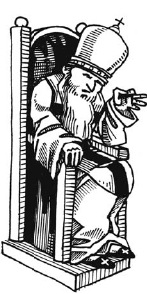
Gregorian chant is the codified liturgy and musical repertory that developed under the Roman leadership with assistance from Frankish kings. The papal choir called the Schola Cantorum (School of Singers) most likely had an influence in the standardization of the chants in the late seventh century, as this choir performed whenever the pope presided in observances. The Frankish kingdom also helped solidify these chant melodies through an order that the Roman liturgy and music be performed throughout that kingdom. The Franks, of course, contributed to this body of liturgical music through their own additions and alterations.

This Frankish-Roman collaboration led to the standardization of chant that is attributed to Pope Gregory I (r. 590-604), who was revered as the founder of the Western church. As noted previously, the Schola Cantorum most likely cemented Gregorian chant's place in music history. Unfortunately for Pope Gregory I, he is most likely receiving undeserved credit, even though legend tells that the chants were revealed to him by the Holy Spirit (taking the form of a dove), and he then dictated and preserved the chants. Charlemagne and his successors spread Gregorian chant throughout their lands, and thus they unified the church (for the most part) through a common music.
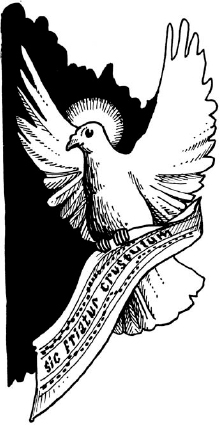
One final repertory of chant that survived until the twelfth century is Old Roman Chant, which not surprisingly was the chant of the city of Rome. Although this dialect of chant essentially drew upon the same liturgies and texts as Gregorian chant, the Old Roman chants were often more ornate. Given their similarities, it is truly impossible to know with any certainty whether Gregorian chant begot Old Roman chant or vice-versa.
Aside from the body of liturgical musical literature that survives from the Middle Ages, probably the single most important development in musical history from this period was the invention of musical notation. Until this time, there was no unified approach to the written transmission of music; while the texts of eighth-century Roman liturgy were recorded on paper, the melodies that accompanied them were passed down through oral transmission. How these melodies were preserved and transmitted is greatly debated and somewhat controversial. While frequently sung melodies could likely have been passed down verbatim from generation to generation, it is unlikely that this was the case for the hundreds of chants that were sung infrequently. It is much more likely that variations appeared with each transmission and that the chants were improvised within established conventions.
As long as chant melodies survived only in the memories of those who sung and heard them, there undoubtedly would be changes or corruptions to the original tunes. The solution to this was notation, a means for writing down the music. In the earliest notations, small signs called neumes (derived from the Latin neuma, meaning “gesture”) indicated the number of pitches per syllable and the ascent or descent of the melody. One important development in the eleventh-century was devised by a monk named Guido of Arezzo, who suggested a series of horizontal lines and spaces that would indicate given pitches. This system, now known as staff notation, gave rise to today's modern music notation. The only problem with this system is that it only could indicate pitch level, not rhythmic duration.
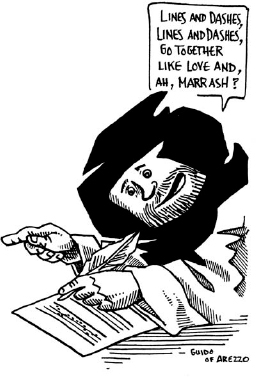
Jumping ahead about 800 years, the Benedictine monks of the Abbey of Solesmes France prepared modern editions of the chants, which was then proclaimed the official Vatican edition by Pope Pius X in 1903. While the Solesmes editions included dots and dashes to indicate lengthened note durations, the problem of notating rhythmic durations was not fully solved. Chant notation still assumed relatively equal rhythmic durations for each of the pitches (which were organized into groups of two and three), which had been the standard for the past 800 years.
Each of the chants was based on one of eight church modes, scales that indicated important features of the chant. The modes informed the chanter of the final (the most important note in the chant and usually the last note in the melody), the range of the chant, and the reciting tone (the second most important note in a mode, often emphasized in the chant and used for reciting text in a psalm). So how would one go about learning how to sing these chants?
Guido of Arezzo, in his infinite wisdom, devised a set of syllables that corresponded to the series of steps and half-steps in the church modes and used the syllables of the first six phrases of the hymn Ut queant laxis: ut, re, mi, fa, sol, and la. Sound familiar? It's the basis of today's modern solfege system, which millions have heard in “Do-Re-Mi” in the musical The Sound of Music. Guido's followers didn't stop there; they created a pedagogical aid called the “Guidonian Hand,” to help singers learn to sing the intervals. The teacher would point to various joints of the open left hand, with a joint assigned to each of the twenty notes of the system.
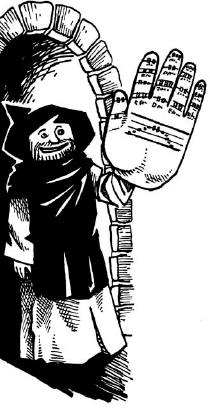
From the codification of liturgical chants, to the development of a method for transcribing melodies, to the development of a solmization system for singing those melodies, the Middle Ages yielded a wealth of developments in music that have strongly influenced the development of music and notation in Western art music.